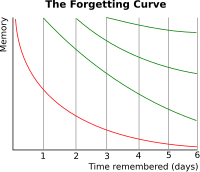Forgetting curve
From Wikipedia, the free encyclopedia
The forgetting curve illustrates the decline of memory retention in time. A related concept is the strength of memory that refers to the durability that memory traces in the brain. The stronger the memory, the longer period of time that a person is able to recall it. A typical graph of the forgetting curve shows that humans tend to halve their memory of newly learned knowledge in a matter of days or weeks unless they consciously review the learned material.
Contents |
[edit] History
In 1885, Hermann Ebbinghaus discovered the exponential nature of forgetting. The following formula can roughly describe the forgetting:
where R is memory retention, S is the relative strength of memory, and t is time.
The first significant study in this area was carried out by Hermann Ebbinghaus and published in 1885 as Über das Gedächtnis (later translated into English as Memory: A Contribution to Experimental Psychology). Ebbinghaus studied the memorisation of nonsense syllables, such as "WID" and "ZOF". By repeatedly testing himself after various time periods and recording the results, he was the first to describe the shape of the forgetting curve.
[edit] Description
The speed of forgetting depends on a number of factors such as the difficulty of the learned material (e.g. how meaningful it is), its representation (see: mnemonic), and physiological factors such as stress and sleep. The basal forgetting rate differs little between individuals. The difference in performance (e.g. at school) can be explained by mnemonic representation skills.
Basic training in mnemonic techniques can help overcome those differences in part. The best methods for increasing the strength of memory are:
- better memory representation (e.g. with mnemonic techniques)
- repetition based on active recall (esp. spaced repetition)
Each repetition in learning increases the optimum interval before the next repetition is needed (for near-perfect retention, initially repetitions may need to be made within days, but later they can be made after years)
There is debate among researchers about the shape of the curve for events and facts that are more significant to the subject. Some researchers, for example, suggest that memories for shocking events such as the Kennedy Assassination or 9/11 are vividly imprinted in memory. Others have compared contemporaneous written recollections with recollections recorded years later, and found considerable variations as the subject's memory incorporates after-acquired information. See flashbulb memory. There is considerable research in this area as it relates to eyewitness identification testimony.
In a typical schoolbook application (e.g. learning word pairs), most students show the retention of 90% after 3-6 days (depending on the material). This means that, in this period, the forgetting curve "falls" by 10%.
[edit] See also
[edit] References
"Memory: A Contribution to Experimental Psychology -- Ebbinghaus (1885/1913)". http://psychclassics.yorku.ca/Ebbinghaus/index.htm. Retrieved on 2007-08-23.
Schacter, Daniel L (2001). The seven sins of memory: how the mind forgets and remembers. Boston: Houghton Mifflin. ISBN 0-618-21919-6.
Baddeley, Alan D. (1999). Essentials of human memory. Hove: Psychology. ISBN 0-86377-544-6.



